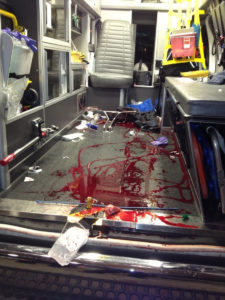 Reading this article about body armor for First Responders I got to thinking about what I would propose to management if I were responsible for the safety of a large contingent of EMS personnel. OSHA requires the employer to assess the workplace and provide the employee with Personal Protective Equipment (PPE) necessary to keep the worker safe if a hazard cannot be mitigated away. Like it or not, I think we have to admit the work environment has changed in the past decade.
Reading this article about body armor for First Responders I got to thinking about what I would propose to management if I were responsible for the safety of a large contingent of EMS personnel. OSHA requires the employer to assess the workplace and provide the employee with Personal Protective Equipment (PPE) necessary to keep the worker safe if a hazard cannot be mitigated away. Like it or not, I think we have to admit the work environment has changed in the past decade.
Needle sticks and back injuries would be my biggest concern and numerous steps have been taken to mitigate the problem but the threat remains.  In today’s EMS work, the threat of violence is present and difficult to mitigate away. Every EMS organization has a policy about waiting until the police advise the “scene is safe” but it’s easy to end up in an unstable or deteriorating situation or be subject to random acting out or criminal acts directed at EMS.
In today’s EMS work, the threat of violence is present and difficult to mitigate away. Every EMS organization has a policy about waiting until the police advise the “scene is safe” but it’s easy to end up in an unstable or deteriorating situation or be subject to random acting out or criminal acts directed at EMS.
I am not an advocate for arming EMS personnel with firearms in most cases. There are pros and cons of body armor. Working with State Police SWAT I had both a light and heavy vest provided by the team. Which vest I used depended upon my role for a particular mission. I could see wearing the light vest working on an ambulance but not the heavy one. If vests were to be provided I would insist on assigning them to each medic. I would not care to put on someone else’s vest after they had been wearing it in 90 degree weather. I think they will be better maintained if the wearer has the maintenance responsibility rather than just placing a couple on a rig. This would also allow the medic to organize the vest pockets to suit their way of working.
I think the assumption of risk increases further for those ambulance crews responding to areas that have a demonstrated higher crime and violence rate than other locations. I’m not a fan of personnel being given the option to buy their own vest. It just sends all the wrong messages to me. It tells me that the employer admits there could be risk but they don’t want to spend the money themselves to address the issue. All things being equal I think providing a ballistic vests shows personnel that the employer is concerned for their safety above and beyond a simple policy statement of waiting until the “scene is safe”. On a large department the cost would be substantial but as an employer I would argue we had the responsibility for providing the appropriate PPE. Waiting until a crew member is shot will likely result in a lawsuit where one of the conditions will be steps to prevent this from happening to others. Like purchasing and providing vests.
Another form of close in personal protection could be obtained through the use of putting a couple of simple devices like a combination flashlight/stun-gun. These are cheap, dual purpose, simple to operate and sold to the public. The main use for these would be extricating the crew from a situation where no weapons were displayed but a threat of physical assault is a potential.
Introducing any type of intervention is going to cost money. Personnel are the most expensive cost of any ambulance service and protecting that investment makes sense. If nothing else your staff may have a little more peace of mind when starting their shift. I’m curious to hear your thoughts on this topic, both from a provider standpoint as a EMS system administrator.



Leave A Comment